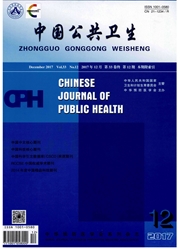

 中文摘要:
中文摘要:
目的了解山东省济南市水源性高碘地区分布及其流行病学状况,为采取科学防治策略提供依据。方法采用横断面调查方法,对该市地处黄河以北2县的所有乡镇按照东、西、南、北、中5个不同方位各抽取5个村庄,每个村庄采集饮用水2份检测饮水碘含量,并了解饮水类型及水井深度。每个村庄采集5户居民食用盐样检测。结果调查2个县的29个乡镇.采集检测居民饮水376份,其水碘含量均值(112.1±91.3)μg/L,中位数90.3μg/L(0.5-605.2μg/L),居民户碘盐覆盖率90.2%。在29个乡镇中存在7个高碘地区,累计受危害199 317人。7个高碘地区都处于黄河以北的黄河冲积平原。集中分布、相连成片。水碘含量与水井深度呈正相关。检测居民随意尿样725份,其尿碘中位数327.0μg/L(35.6-2938.5μg/L)。检查居民甲状腺725人.甲状腺肿大率4.8%。结论济南市现有7个高碘地区,居民甲状腺肿大率在正常范围,但其碘营养水平呈过剩状态,应停止碘盐供应,采取分类防治策略。
 英文摘要:
英文摘要:
Objective To master the present conditions of iodine excess and its epidemiology in Jinan city, for providing the evidence for control. Methods A cross section was adopted for the epidemiological survey in all of townships from 2 counties. Two samples of drinking water from each village were tested for water iodine content as well as the data regarding to their resourses and the depth of wells. Five samples of edible salt were collected for quantitative analysis at each village. Resuits Twenty- nine townships were investigated. Three hundred and seventy six samples of drinking water were tested, in which values of iodine content were(112.1 ± 91.3)μg/L in mean, 90.3μg/L (0.5 - 605.2 Mg/L) in median. The rate of iodized salt is 90.2 %. About twenty thousand people were at risk for iodine excess arid living in 7 townships where iodine concentration was over 150 μg/L in drinking water. All of them were mainly located in alluvial plain of Yellow river. There was positive relationship between content of iodine water and its depth of well. The medium of urinary iodine in 725 inhabitants from 29 townships were 327.0 μg/L (35.6 - 2938.5 μg/L). Thyroid goiter rate(TGR) of 725 subjects was 4.8%. Conclusion There were 7 areas with iodine excess in drinking water in Jinan. TGR was in normal range, but the nutrition level of iodine was excess in inhabitants. It was suggested that iodized salt supply should be stopped in 7 townships and taking different strategies against iodine deficiency or iodine excess in the city.
 同期刊论文项目
同期刊论文项目
 同项目期刊论文
同项目期刊论文
 期刊信息
期刊信息
